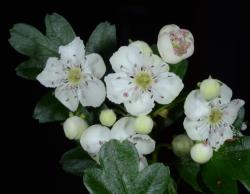- Taxon
- Weed
- Gallery
Shrub or small tree, up to 10 m when mature, armed with axillary spines up to 12–(20) mm long, the longest spines associated with short flowering shoots; stems glabrous, smooth and reddish brown when young but becoming grey when older. Lvs solitary on vigorous vegetative shoots but in fascicles on short shoots; petiole 5–25 mm long, greenish, narrowly winged, grooved above; blade ± deltoid to rhombic, (25)–35–50–(70) × (25)–35–45–(70) mm, deeply lobed, glabrous, dark to mid green above, paler below with primary veins obvious, deeply lobed; lobes 3–7, ascending, oblong, usually entire in lower 1/2 and sparingly and irregularly serrate near the acute apex; stipules of vegetative shoots reniform with prominently toothed margins, those of short shoots smaller and deciduous. Fls many in flat corymbs on leafy short shoots scattered along branches; corymbs subtended by small, leafy, acute bracts; bracts often larger and toothed on younger stems; pedicels 5–11–(18) mm long, often bearing scattered, fine, white hairs. Sepals greenish, finely pilose at least in lower part; lobes triangular to oblong, subacute, becoming reflexed. Petals broadly ovate to orbicular, 4–8 mm diam., rounded to crenulate, spreading, usually white, rarely red-pink. Stamens < petals; filaments white or sometimes pale pink; anthers pink. Style usually 1. Fr. broadly oblong to subglobose, 7–11 mm diam., dark red, shining, crowned by deflexed sepals; nutlets usually 1.
[From: Webb et al. (1988) Flora of New Zealand. Volume 4.]
Flowering: Oct.–Nov.; Fruiting: Dec.–Apr.




